

Economic leakage in tourism is bad- here’s why
Disclaimer: Some posts on Tourism Teacher may contain affiliate links. If you appreciate this content, you can show your support by making a purchase through these links or by buying me a coffee . Thank you for your support!
Economic leakage is a major problem in the tourism industry. Destinations develop and grow their tourism industries with high hopes of making a significant income from the various tourism-associated activities. However, in many destinations, this is simply not the case.
I have seen economic leakage first-hand throughout almost all of my travels . Whether it’s Ryanair bringing the tourists to the area yet taking their money back to Ireland, Hilton Hotel taking the tourist Dollar back to the US or the imported Minute Maid orange juice that is sold in shops and restaurants (even though there is perfectly good orange juice made in-country), economic leakage in tourism is everywhere you look!
In this post I will explain to you how economic leakage in tourism occurs and how you can be a more sustainable tourist by thinking carefully about how you spend your money.
What is economic leakage in tourism?
Why is economic leakage a problem, where does your money end up, booking local, hotel chains, tour operators, restaurants, coffee shops, foreign employment, enclave tourism, wider economic leakage (the butterfly effect), how you can reduce economic leakage in tourism, conclusion: economic leakage in tourism, further reading on economic leakage in tourism.
Economic leakage is the act of money leaving the host country and ending up elsewhere.
Due to the international nature of the tourism industry, along with the world that we live in becoming increasingly globalised and monopolised by the most successful multinational corporations (MNCs), economic leakage is becoming more and more prevalent.

Economic leakage can occur in a number of ways. Here are a few examples:
- Imported goods
- Foreign ownership
- Currency conversion
Most destinations choose to develop and grow their tourism industries with the aim of making money. Unfortunately, the income that destinations receive from their tourism industry often isn’t as high as they would like it to be. In severe cases, the destination receives only a small fraction of the income from tourism.
- If you think about it, it’s actually quite unethical!
- Is it fair that we use their natural resources ( beach , mountain, jungle etc), but that they receive very little money from us in return?
- Is it fair that we leave litter on their streets and they have to pick up the bill to clean it up?
- Is it fair that we use up their water supply (which is often scarce in hot countries)?
- Is it fair that the price of real estate rises because the land is in demand, meaning that local people may be displaced and have to move areas?
The tourism industry contributes to all of these issues and more, yet in many cases very little money is directed towards the destination to help deal with such problems.

The economic problems resulting from leakage go even further than this. Many destinations will give up their traditional ways of making money, for example through farming, in exchange for tourism. They see Dollar signs- they think tourism is where the money is at!
But they are misled, misguided or simply uneducated in basic economics to realise that this is, in actual fact, not always the case. If managed well, destinations CAN maximise their income from tourism and minimise economic leakage. BUT, many tourism industry stakeholders do not have the experience or education to realise this.
- They welcome the MNCs with open arms.
- They give the airline a ridiculously cheap deal to operate in and out of their airport.
- They stock the (international) products that tourists are familiar with instead of using local products
- They employ the staff from overseas instead of training their own people
- They don’t realise the impacts of their actions, and before they know it, they have a thriving multi-million Dollar tourism industry that makes the destination very little profit. Ironic, huh?
What’s more, is that if the destination did give up their traditional ways of making money in exchange for tourism, then they no longer have the income from this industry either. In effect, the destination may actually be WORSE OFF than they were BEFORE they developed their tourism industry!
When we travel, it is important that we give a thought to where our money ends up. Yet, for the average tourist, this is not something that will typically cross their mind.
We hop on over to Expedia or a comparison site such as Icelolly.com and find a holiday. It’s all organised for us, making it really simple. Just get your credit card and click book. For most people, that’s the end of the road. Aside from working out how much spending money they need and changing their currency, they don’t give another thought to money matters.
If you want to be a more sustainable tourist , give some thought to where your money goes. Whilst you will never truly know where every Penny that you spend ends up, there are things that you can do to help to avoid economic leakage.
If you book with a local tour operator, local tour company or local hotel you know that your money is going to a local business.
When I was planning our tour around Sri Lanka , I received quotes from several tour operators. Some were local and some were not. What I quickly realised, however, was that there were actually several benefits to booking local.
- I knew my money would stay in Sri Lanka.
- The Sri Lankan company had better knowledge of the country
- It was cheaper
If you think about it, it actually makes little sense to book with a foreign owned company. Who knows more about the local area than the locals themselves? Plus, if you cut out the middle man then you save money too. That’s a win, win in my book!
The impact of multinational corporations
MNCs, also known as transnational corporations, are large businesses that operate across different countries. MNCs are often very powerful organisations that are multi-million Dollar businesses. However, the money that they make is most commonly returned to the country where they are based, which is usually in Western countries such as the USA or the UK.
If you are interested in learning more about how powerful MNCs are and how they operate, I recommend Multinational Corporations and Foreign Direct Investment: Avoiding Simplicity, Embracing Complexity , which provides some excellent explanations and case studies.
Here are some examples of companies that you might come across on your travels:
- Travel Lodge
- Thomas Cook
- Various subsidiaries of the companies named above
- Dominoes Pizza
- Planet Hollywood
- Hard Rock Cafe
- Costa Coffee
Many organisations, particularly those that are foreign owned, will choose to recruit staff from overseas instead of those who live in the local area.
Organisations have several reasons for this. To begin, foreign staff are probably native English speakers, whereas the local people may not be. Staff are likely to be familiar with the brand and with Western customs. Staff hired from abroad may already be working for the company and may have a more qualified CV than local people.
HOWEVER…. have you ever heard this saying?
‘You give a poor man a fish and you feed him for a day. You teach him to fish and you give him an occupation that will feed him for a lifetime.’
Hiring foreign people is really just short term gain. It would actually make more sense to teach the local people how to do the job. They can then teach the next generation of people in the area and so on and so forth.
And like I said before, surely the locals know more about their own country than any foreigner?

Thomas Cook is a good example here. For many years they used predominantly British Holiday Reps in their mass tourism holiday resorts overseas. They would fly them in to the destination and provide the staff with accommodation and a salary, paid into a UK bank account. The person would pay UK taxes. The British Holiday Reps would need to learn about the destination they were placed in on their arrival, taking a crash course or learning on the job.
Lets say I am on a holiday in Jamaica. I ask my Rep where is the best place to eat authentic Jamaican food, or to tell me a bit about local politics. Maybe I want to know directions to a place or I’d like a a background history on one of the monuments that I saw near the hotel. Who is more likely to know the answers to such questions? A Brit or a local?
To me, it seemed crazy that Thomas Cook, and many organisations like them, would be sending over foreign staff to advise on a destination that they know little about in real terms compared to the local population (fortunately Thomas Cook did changes this in many destinations, but not all, prior to their collapse in 2019).
Furthermore, by not hiring local people, tourism businesses and their staff may become unliked by the local community. The local people may even begin to resent them. This can cause all sorts of wider issues such as rises in thefts and hate crimes.
Enclave tourism is tourism that is all-encompassed by the tour operator.
Tourists are encouraged to stay put. They are often encouraged not to leave their hotel. This is generally associated with the all-inclusive holiday , whereby tourists purchase a holiday package that includes everything they need from transport to food, drink and entertainment. The tourists have no need to leave the resort, and they often don’t.
In cases of enclave tourism, very little money reaches the destination within which the tourism takes place. In cases such as the Maldives or the Caribbean, there have been reports of as much as 95% of the money made by tourism leaving the country via economic leakage.
One destination which has suffered from this is The Gambia . The Gambian Government even tried to ban all-inclusive resorts, but when the tour operators threatened to take their business elsewhere, the ban was retracted.
Have you ever heard of the butterfly effect?
This is when one thing happens, which causes another to happen, which then has a knock on effect on something else and so on. It demonstrates how everything is interconnected and how things that may not seem important, may have important consequences.
The butterfly effect is actually a very interesting concept and if you are interested, then I recommend the book The Butterfly Effect: How Your Life Matters . It’s written by New York Times best-selling author Andy Andrews who shares a compelling and powerful story about a decision one man made over a hundred years ago, and the ripple effect it’s had on us individually, and nationwide, today. It’s a story that inspires courage and wisdom in the decisions we make, as well as affect the way we treat others through our lifetime.
Anyway, I digress…. back to economic leakage in tourism…
So the reason this is relevant is because it demonstrates how the tourism industry is, in effect, an economic system. The different parts of the ‘ tourism system ‘ are connected in many different ways. So if one part of the system is changed, this will have a knock on effect on other areas in the system.
Let me give you an example…
TUI decides to change its policy and next season they will hire only local Holiday Reps. As a result, recruitment takes place in the destination, instead of back in the UK. Money is spent on hiring a venue in the destination to hold interviews and interviewers (or their employer) spend money on aspects such as accommodation, food and entertainment. All of this is money that the destination did not receive the year prior, when recruitment took place in the UK.
When local staff are employed they are given training. This provides the local community the opportunity to acquire skills that they otherwise wouldn’t be able to learn. They can then teach these skills to their friends or family, who can use them in other areas of their lives, perhaps enhancing their own employment prospects.
Local staff will pay local taxes. These taxes will be collected by the Government and (hopefully) reinvested in the community. Areas such as healthcare and education benefit from this boost in money. Children now receive a better education because there is more money in the system. This improves their future employment prospects.
The story continues…
As you can see, economic leakage is not a good thing to the destinations which host tourism. The only people who benefit from economic leakage are the large MNCs and the staff who work at the top end of these businesses.
Whilst this is a huge issue, there are things that we can do as individual tourists to help prevent economic leakage in tourism.
Here are some examples:
- Book your holiday through a local tour operator
- Use independently, locally owned accommodations, such as Airbnb
- Use local transport options (i.e. take a taxi instead of booking a transfer before you leave home)
- Buy from local shops
- Buy local produce (forget Minute Maid and buy locally squeezed juice- it will probably taste nicer anyway!)
- Don’t purchase imported goods
As you can see, economic leakage is a big problem in the tourism industry. However, many tourists are unaware of how much impact their travel decisions can have on the economy of the destination that they are visiting.
With a little more awareness, tourists can help to maximise the economic potential from tourism for local communities and reduce economic leakage.
And hopefully this post has done just that!
For more information, I recommend some of the texts below. I also have a discount code for Airbnb if you fancy trying it out! Get your discount code here .
- Basic Economics, Fifth Edition: A Common Sense Guide to the Economy – Drawing on lively examples from around the world and from centuries of history, Sowell explains basic economic principles for the general public in plain English.
- The Business of Tourism Management – an introduction to key aspects of tourism, and to the practice of managing a tourism business.
- Managing Sustainable Tourism – tackles the tough issues of tourism such as negative environmental impact and cultural degradation, and provides answers that don’t sacrifice positive economic growth.
- Tourism Management: An Introduction – An introductory text that gives its reader a strong understanding of the dimensions of tourism, the industries of which it is comprised, the issues that affect its success, and the management of its impact on destination economies, environments and communities.
Liked this article? Click to share!
Tourism’s dirty secret: What is tourism leakage and how can you avoid contributing to it?
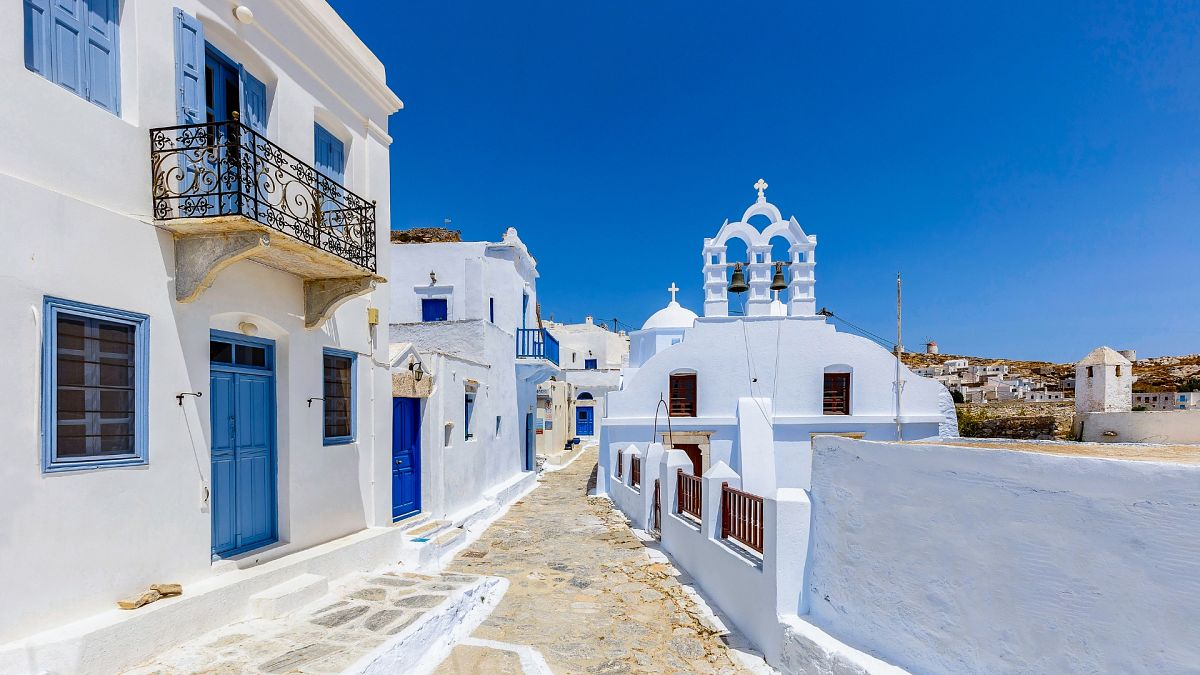
Is your holiday paying its way? Here’s how to benefit local people and nature this summer.
Sarah Faith is a content and values writer at activist travel company, Responsible Travel.
Almost 600 million tourists visited Europe in 2022, and this year is shaping up to be the busiest travel season since 2019.
But there’s a dirty secret swirling around the flood of tourists returning to Europe’s hotspots: tourism leakage.
Book that all-inclusive holiday in Greece and how much of your money will end up in local people’s pockets? Precious little.
In fact, for most all-inclusive mass tourism package holidays, 80 per cent of your cash heads overseas - away from local communities - according to the UN World Tourism Organization.
It’s called tourism leakage, and it happens when an international company provides your hotel , flight, car hire and excursions, when you eat imported food, or dine at international chain restaurants.
It’s money that could instead be used by local communities to restore nature , support local livelihoods, protect cultural traditions or maintain vital infrastructure. And in destinations suffering from overtourism - places where too many visitors are eroding the very fabric of everyday life - tourism leakage compounds the problem.
But tourism needn’t be leaky or destructive. Here’s are five ways to increase the good your holiday can do this summer, put money in local people ’s hands, and take the pressure off destinations ready to burst at the seams.
5. Stay, shop and eat local
Of course, it’s impossible to reduce tourism leakage to zero. But there are ways to maximise how much of your holiday money stays local.
A simple way to start is to prioritise locally-owned accommodations and restaurants, avoid Airbnb hosts who buy up swathes of homes for short-term rentals, and use local guides.
And think about where your food is coming from too - has it been sourced from local producers?
Helping communities thrive economically benefits your holiday too. It means more money for better facilities, cleaner beaches, efficient local transport and a thriving local restaurant scene. You’ll find local people will likely be much more welcoming of tourists, too.
4. Look for alternatives to the tourist hotspots
Since 2017, Spain has faced a tourism rebellion. Fed up with entire neighbourhoods being lost to short-term holiday lets, souvenir shops and tourist bars, residents of Barcelona have been on an anti-tourism warpath.
Pre-pandemic, slogans telling tourists to go home were graffitied across the city, and masked protestors slashed the tyres on a tour bus.
Mallorca , too, is turning away from its traditional tourist markets. After considering measures to limit overcrowding, the island’s tourism director Lucia Escribano made pointed remarks earlier this month, saying they are “not interested in having… budget tourists from the UK”, while Lanzarote has declared itself a “tourist saturated destination”.
But this year Spain is set to receive more international visitors than it had before the pandemic.
Choosing alternative destinations takes the pressure off popular sites and spreads the benefits of tourism into communities that otherwise miss out.
- Amsterdam to ban cannabis smoking in public to curb ‘grim’ tourist behaviour
- Barcelona increases its tourist tax this week: Where else will you have to pay to enter in 2024?
So, why not consider Girona or Tarragona over Barcelona ? Or for a real taste of Catalan culture, head into the region’s hilly hinterland where medieval villages hang precipitously over the cliffs of the Garrotxa Volcanic natural park.
Swap out the cruise crowds which flood into Croatia for the Albanian Riviera - a stretch of Ionian coastline that shares the same water as Corfu. Here you can explore the mountainous forests of Llogara National Park for wildlife treats and fabulous walks against a backdrop of dazzling blue.
Or, choose a lesser-visited Greek island (there are 6,000 of them after all) over Mykonos or Santorini. Try Kynthos for delicious cheese and honey, take in the sea views from whitewashed, blue-shuttered Amorgos, or enjoy the faded grandeur of Syros, with its neoclassical facades.
If you’re not sure whether your holiday could be contributing to an overtourism problem, check out Responsible Travel’s overtourism map and search for any news reports before you book.
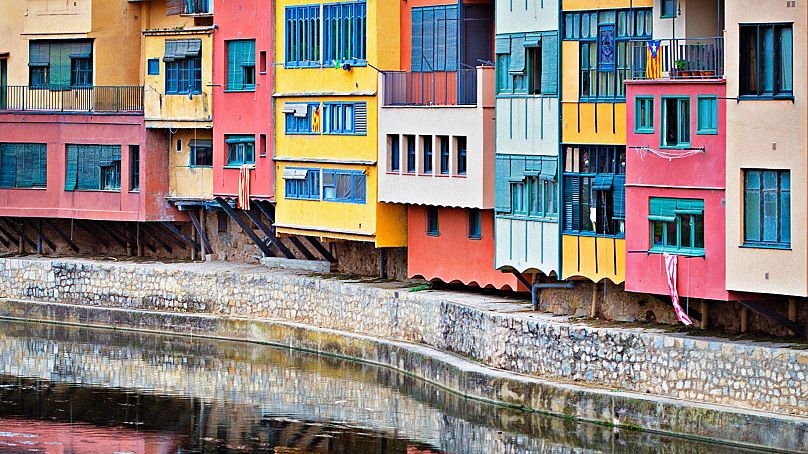
3. Go niche for an experience rooted in the community
Specialist tourism businesses are often firmly rooted in local culture and landscapes. They can help spread out the impacts of tourism and ensure more out-of-the-way communities benefit from the money you spend.
So, why not use your holiday to indulge your love of kayaking, hiking or painting?
Walking holidays in Spain, for example, are best off-season when it’s cooler, and will take you into less-visited areas like the Picos de Europa mountains in Asturias or the inland Sierra de Grazalema in Andalucia.
Food-focussed trips champion local producers and farmers’ markets, while wildlife tours follow in the footsteps of animals, not other tourists.
Visit Romania’s fairytale Carpathian Mountains and you’ll find some of the largest populations of wolves and bears in Europe, yet the numbers of tourists here are a fraction of those arriving in Austria, Switzerland or other popular mountain destinations.
Travel with a local specialist in winter for the best chance to see wildlife, with money from your trip invested in locally-owned businesses, local guides and conservation initiatives.
2. Switch to flight-free travel
Holidaymakers on autopilot think flying is the cheapest and quickest way to travel - but it’s not always the case.
With fuel (and therefore flight) prices soaring, and Europe’s rail network growing rapidly, travelling by train makes more sense than ever.
Not to mention the environmental impact: flying from London to Paris emits 14 times the amount of CO2 than journeying by train.
- Want to travel more sustainably in 2023? We asked flight-free travellers how they do it
- Europe's most exciting long-distance train routes for 2024, including prices and how to book
New rail routes - including between Vienna and Paris, and Berlin and Brussels - are making slow travel adventures even easier.
With France having become the first country to announce it will abolish some short haul domestic flight routes in favour of rail alternatives, using a train over a plane could become the norm.
Besides being a sociable, often scenic , and comfortable way to arrive at the start of your summer holiday, travelling by train also limits the environmental damage done to your chosen destination.
1. Add in a conservation element to your holiday
Local people aren’t the only ones short changed by tourism leakage. Nature - which every type of trip impacts - doesn’t benefit either. And, with biodiversity in crisis, tourism can’t just take from nature, it must help restore it too.
Getting nature positive can be as simple as donating to a local conservation project in your destination, signing up for a local community litter pick (global organisation TrashHero organises free-to-join clean-up projects via social media) or choosing to volunteer during your holiday.
Citizen science projects - like this one monitoring dolphins off Italy’s Ligurian coast - make a lasting contribution to ongoing conservation research, while you enjoy sailing the Mediterranean and indulge in delicious Italian seafood.
So, think local this summer. When money from tourism leaks out of the destination you’re visiting, nature, local communities - and ultimately your holiday - are all the poorer for it.
You might also like
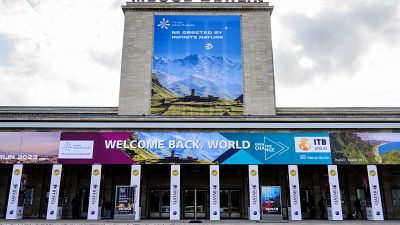
Travel trade fair ITB bounces back after Covid-19
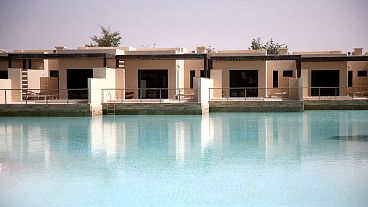
Spas, retreats and fitness: Where to go for a wellness break
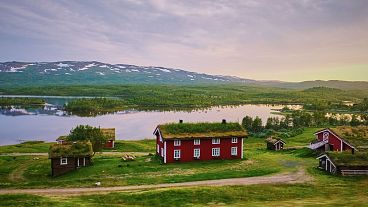
Revealed: 17 of the top 20 most sustainable destinations are in Europe
Economic Leakage in Tourism: What It Is and How to Prevent It

Tourism is a significant driver of economic and social development. It is responsible for generating income, employment, investment, and ultimately, improving the quality of life for locals. But local communities in different destinations are not fully experiencing the benefits of this activity due to economic leakage in tourism.
When it happens, all the investment and effort put into growing tourism doesn’t pay off once part of the money generated by this industry leaves the host city or country.
This blog covers what economic leakage in tourism is, its consequences and what actions to take in order to keep tourists’ expenditures inside your destination.
What is economic leakage in tourism?
Tourism leakage happens when the revenue generated through tourism is lost to other countries or economies.
Tourism is an activity that traditionally brings foreign currency into a country’s economy. But due to globalization and travel conglomerates , this money is likely to leave the host country preventing the economic and social development of touristic areas.
Historically, economic leakage in tourism is more significant in developing countries . Sometimes it can nearly neutralize the money generated by tourism activity.
In Fiji, it is estimated that 60% of the money earned through tourism ends up leaving the country . In another study, tourism leakage estimates range from 40% in India to 80% in the Caribbean .
What triggers economic leakage in tourism?

Leakage is intrinsic to tourism and is present in all countries. However, its intensity varies in degree depending on how developed the destination is and the actions taken in order to prevent it.
Basically, leakage occurs through six main mechanisms :
1) Good and Service
In order to supply travelers’ demands, many destinations import goods and services. This type of economic leakage in tourism is more noticeable in islands, which are highly dependent on imports.
2) Infrastructure
In this case, tourism leakage happens when the host country doesn’t have the ability or technology to build tourism-related infrastructure and depends on foreign companies for it. For example, to build airports and ports or to implement a new travel technology.
3) Foreign ownership
When the tourism industry is not well-developed in a destination, it’s common for governments to attract foreign investment in order to start the activity in that area. However, when foreigners have ownership of the touristic infrastructure, the profits generated by this activity are taken away from the host market. That is the case in a destination dominated by international resort chains, for example.
4) Promotional expenditures
Having an international presence is paramount for many destinations, on the other hand, it’s a source of tourism leakage. When a destination invests in attracting foreign visitors , the money spent on advertisement and publicity goes abroad.
5) Tax exemptions
When a destination gives tax exemptions to foreign investors it is giving up tourism income. This strategy to grow the tourism industry is common in developing destinations, but it should be well planned in order to not harm the local community.
6) Foreign employment
During the high season, the increase in demand leads to the opening of temporary job opportunities. This often attracts foreign workers interested in making money and leaving the destination after the end of the season.
Why is economic leakage in tourism an issue for destinations?
Although tourism has lots of benefits —it boosts the local economy, creates new jobs, promotes cultural exchange— on the other hand, it also has negative impacts :
- Puts pressure on the local infrastructure
- Impacts the environment
- Changes the daily life of residents
- Drains local resources
- Affects the local production chain
- Increases the demand for goods, services and accommodations, which rises their prices
When the money earned through tourism leaves the host destination, little or nothing can be done in order to mitigate these bad impacts and promote social, cultural and environmental well-being for the local community.
Hence, tourism stops being an attractive investment and turns into an issue for the destination.
How can tourism stakeholders prevent tourists’ expenditures from leaving a destination?

Tourism leakage is harmful to destinations, especially the ones that rely on tourism as the primary source of income.
In order to prevent it, the government, destination managers, travel companies, the local industry, residents and visitors should work together to make sure the money spent on this activity is reaching the right pockets.
Some actions that destination leaders can take in order to reduce economic leakage in tourism are:
- Support local suppliers
The host community is a great source of workforce, services, and products that should be integrated into the local tourism industry. Destination managers should incentivize travel companies to buy from local producers before searching for suppliers abroad.
- Attract conscious travelers
Destination marketers should invest in campaigns to attract conscious travelers . This type of traveler knows the importance of tourism as an economic and social driver for the host community. They make sustainable choices, support the local suppliers and protect the environment.
- Promote niche tourism
Travelers looking for a niched experience are interested in discovering the local culture, history, culinary and hidden gems. Unlike mass tourism, which is usually offered by international companies and associated with overtourism, niche tourism is often offered by locals to a small group of travelers.
- Incentivize local companies
Instead of giving tax exemptions to international companies, try reducing the taxes for local accommodations, operators and producers. A relief in taxes gives a chance for the local tourism ecosystem to flourish.
- Limitate the presence of multinational corporations
All-inclusive packages are very popular among travelers. The issue is that about 80% of travelers’ expenditures on these packages go to international corporations . By restricting the presence of these companies in a destination, travelers should turn to local providers in order to have a complete stay.
- Stimulate the diversification of the local economy
The more dependent on tourism a destination is, the bigger the tourism leakage. A destination with a diversified economy has more bargaining power when dealing with international investors.
- Digitalize the tourism offer
Increasing the online exposure of local travel providers is a way to drive them more bookings. Destinations that are digitalizing their tourism offer, such as Visit Zagorije , not only make local companies more competitive but also facilitate the booking process for visitors.
Tourism leakage is an issue all destinations have to deal with. When not addressed, tourism income is drained out of the local community, preventing its economic, social and environmental development.
In this article, we have presented seven initiatives to fight back economic leakage in tourism :
If you are a destination manager or marketer interested in empowering your local tourism stakeholders, SmartDestination is the right partner for you. We are a group of award-winning tech companies specialized in travel, tourism and hospitality with a complete solution to digitalize your tourism offer.
Contact us if you want to boost your travel and tourism product.
10 Travel Trends That Will Shape Tourism in 2023

The past years were marked by uncertainty in the tourism industry. The traveler was learning how to cope with closed borders and often had their plans blown by the constant changes in the travel rules. However, 2022 was different. This...
Why Destinations Should Promote Agritourism

The pandemic was a change driver in many aspects, including in the way people are choosing to travel. Before mass tourism was the rule, now the modern traveler is seeking slower, more in-depth experiences. Many destinations from all over the...

Take The First Step Towards Smart Tourism!

© 2021 SmartDestination. All rights reserved.

- BBA Public Accounting
- BBA General Business
- BBA Finance
- BBA Management
- BBA Marketing
- BBA Risk Management & Insurance
- Master of Business Administration (MBA)
- Certificate in Accounting
- Certificate in Banking & Financial Services
- Certificate in Financial Literacy
- Certificate in Financial Technology & Cybercrime
- Certificate in Global Supply Chain Management
- Graduate Certificate in Functions of Business
- BS Child & Family Studies – Child Development
- Certificate in Early Childhood Director
- Certificate in Family Services
- Certificate in Infant/Toddler Care and Education
- BA Communication Studies
- Certificate in Communication Studies
- Certificate in Dispute Resolution
- Certificate in Communication in the Workplace
- MS Computer Science
- Certificate in Artificial Intelligence in Data Science
- Certificate in Cybersecurity and Digital Forensics
- Certificate in Game Design
- AA Police Studies
- BS Corrections & Juvenile Justice Studies
- BS Criminal Justice
- BS Police Studies
- MS Criminal Justice Policy & Leadership
- Certificate in Correctional Intervention Strategies
- Certificate in Juvenile Justice
- BS in Elementary Education
- MAEd Master of Arts in Education
- MAT Master of Arts in Teaching
- EdS Specialist in Education
- AS Paramedicine
- BS Emergency Medical Care — Emergency Services Administration
- BS Emergency Medical Care — Fire Service
- BS Fire, Arson & Explosion Investigation
- BS Fire Protection Administration
- BS Fire Protection & Safety Engineering Technology
- Certificate in Industrial Fire Protection
- AA General Studies
- BA General Studies
- BS Health Services Administration
- BS Homeland Security
- MS Safety, Security & Emergency Management
- Certificate in Homeland Security
- Certificate in Security Management
- BS Global Hospitality and Tourism
- Undergraduate Certificate in Gastronomic Tourism
- Undergraduate Certificate in Sustainable Hospitality
- MS Instructional Design & Learning Technology
- Graduate Certificate in Online Learning Design
- Graduate Certificate in User Experience Design
- MS Nursing – Rural Health Family Nurse Practitioner
- MS Nursing – Psychiatric Mental Health Nurse Practitioner
- DNP Post-MSN DNP
- Post-MSN Certificate – Family Nurse Practitioner
- Post-MSN Certificate – Psychiatric Mental Health Nurse Practitioner
- BS Occupational Safety
- MS in Safety, Security & Emergency Management
- Graduate Certificate Construction Safety
- Graduate Certificate in Cyber & Security Management
- Graduate Certificate in Emergency Management & Disaster Resilience
- Graduate Certificate Healthcare Safety
- Graduate Certificate in Occupational Safety
- Graduate Certificate in Safety Leadership & Management
- Graduate Certificate in Supply Chain Safety & Security
- Certificate in Social Intelligence & Leadership
- Bachelor’s to OTD
- Master’s to OTD
- AAS Paralegal Studies
- BA Paralegal Science
- Post-Baccalaureate Certificate in Paralegal Science
- BA Political Science
- BS Psychology
- Certificate in Veterans Studies
- MS Psychology-Applied Behavior Analysis
- MS Industrial Organizational Psychology
- Graduate Certificate in Psychology — Applied Behavior Analysis
- MPA Public Administration
- Certificate in Community Development
- Certificate in Emergency Management & Disaster Resilience
- Certificate in Applied Policy
- Certificate in Non-Profit Management
- Master of Public Health – Health Promotion
- BSW Social Work
- MSW Social Work
- Certificate in Addictions Intervention
- Certificate in Child & Family Services
- Certificate in Leadership & Management
- Certificate in Mental Health
- Certificate in Social Advocacy & Justice
- BS Sport Management
- See All Programs
- Types of Financial Aid
- Applying for Financial Aid
- Understanding Financial Aid
- Financial Aid Policies
- Scholarships
- How to Apply
- Application Deadlines
- Admission Requirements
- Transfer Students
- Transfer from KCTCS
- Visiting & Non-Degree Seeking Students
- Corporate Educational Partnerships
- State Authorization & Professional Licensing Information
- Student Resources
- Faculty Resources
- Online Military Students
- BBA Risk Management & Insurance
- BS Child & Family Studies – Child Development
- BS Corrections & Juvenile Justice Studies
- MS Criminal Justice Policy & Leadership
- BS Fire, Arson & Explosion Investigation
- BS Fire Protection & Safety Engineering Technology
- MS Safety, Security & Emergency Management
- MS Instructional Design & Learning Technology
- MS in Safety, Security & Emergency Management
- Graduate Certificate in Cyber & Security Management
- Graduate Certificate in Emergency Management & Disaster Resilience
- Graduate Certificate in Safety Leadership & Management
- Graduate Certificate in Supply Chain Safety & Security
- Certificate in Social Intelligence & Leadership
- Certificate in Emergency Management & Disaster Resilience
- Certificate in Child & Family Services
- Certificate in Leadership & Management
- Certificate in Social Advocacy & Justice
Impact of Tourism Leakage and How to Prevent It
When you spend money at a tourist destination for your vacation, where does all that money go? Ideally, the tourism dollars you’ve spent at a destination should go into supporting the local economy no matter how or where you spent the money. If tourism is good for the economy, it therefore must be a source of sizable income in the host destinations. However, this is not always the case. Frequently, a significant amount of the money tourists spends while traveling ‘leaks’ out of the destinations. For various reasons, the money ends up elsewhere. The money is directed to large, international tourism companies that are foreign-owned or based in another country. Especially when associated with mass tourism and high-end, all-inclusive luxury tourism, leakage often occurs in developing nations where they need the revenue the most.
Tourism leakage causes inequality
First of all, tourism leakage is unethical because it causes inequality. According to the UN’s Ocean Atlas, of each $100 spent by a tourist from a developed nation, only around $5 actually stays in the local economy of a developing country destination. There are two main sources of tourism leakage which are import leakage and export leakage.
What is import leakage?
Import leakage happens when the tourist demand for certain products/services cannot be met by the local economy. In those cases local suppliers look somewhere else to import the goods/services the tourists want. For example, instead of buying locally produced orange juice, a tourist buys an imported Minute Maid orange juice. Up to 50% of tourism income for developing countries is said to be lost through import leakage.
What is export leakage?
Export leakage, on the other hand, is when foreign investors take the tourism profits out of their operating destinations and back to their home country. For example, a multinational corporation (MNC) buys a private beach on an island in the Caribbean and develops a luxurious, all-inclusive resort. Despite making a profit off this island and employing local workers, the tourism income made from this resort is getting sent back to the company’s headquarters overseas. This keeps lining the pockets of large MNCs while local communities continue to suffer, worsening global inequality.
Tourism leakage and cultural erosion
Another problem is that leakage can cause cultural erosion. If tourists keep demanding products from back home, only stay in large resorts created by global companies, or only buy from expensive foreign brands, there is little room for local cultures to grow and many locals get driven out of their own communities due to heightened housing costs in favor of more profitable tourism establishments. Eventually, global cultures can end up becoming diluted and less diverse. Therefore, it is important for tourists to actively seek local cultures and experience them. By learning about the local cultures and respecting them, those cultures can flourish.
How do we prevent tourism leakage?
One of the easiest ways is to buy local and stay local. Import leakage can be prevented by spending money on local products, staying in local accommodations, and eating at local restaurants. Another way is to avoid foreign-owned, all-inclusive package tours. Sometimes it can be hard to avoid them as some destinations may not offer any other option or some people may not be able to travel in any other way. But you can do small things to help prevent excess leakage by seeking out locally-owned accommodations or even homestays for authentic experiences. If you do opt for an all-inclusive, you may be able to find a local company or a company that hires and trains locals in management positions or sources food and products locally. You can also look for those companies that give back to their operating destinations to help minimize the negative impacts of tourism leakage.
There are many more ways you can help prevent tourism leakage. If you would like to learn more about tourism leakage or about sustainable and responsible tourism, you can start by studying Global Hospitality and Tourism at Eastern Kentucky University.
By: Jeongyeon (Jennie) Ahn, PhD, assistant professor, EKU Global Hospitality and Tourism
Interested in working in the tourism industry?
Earn your bachelor’s degree from a regionally accredited university that has been an online education leader for over 15 years. Complete the form to learn more about how you can earn your bachelor’s in global hospitality and tourism . You can also earn an in-demand certificate in gastronomic tourism or sustainable hospitality along the way.
Leakage, economic
- Reference work entry
- First Online: 01 January 2016
- Cite this reference work entry

- Cristina Jönsson 3
82 Accesses
Leakage occurs in many industries. In the case of tourism, the causes for economic leakage depend on the destination and its development . In general, tourism leakage takes place when revenues from its economic activities are not available for reinvestment or consumption of goods and services within the same destination. As a result, economic resources are “leaked away,” which predominantly occurs when tourism companies are foreign owned and/or when they are based in another country. Large-scale leakage has been associated with mass tourism and high-end, luxury tourism (Scheyvens 2002 ), both of which tend to be externally controlled. Leakage also occurs when tourism-related goods, services, and labor are imported. Thus, it is difficult to avoid leakage, especially in small island developing states that depend on the import of skilled staff (Mbaiwa 2005 ) and goods and services (Torres 2003 ).
Due to the complexity of leakages, there are challenges with its calculations, especially in...
This is a preview of subscription content, log in via an institution to check access.
Access this chapter
- Available as PDF
- Read on any device
- Instant download
- Own it forever
- Available as EPUB and PDF
- Durable hardcover edition
- Dispatched in 3 to 5 business days
- Free shipping worldwide - see info
Tax calculation will be finalised at checkout
Purchases are for personal use only
Institutional subscriptions
Mbaiwa, J. 2005 Enclave Tourism and its Socio-economic Impacts in the Okavango Delta, Botswana. Tourism Management 26:157-172.
Article Google Scholar
Mitchell, J., and C. Ashley 2007 “Leakage” Claims: Muddled Thinking and Bad for Policy? London: Overseas Development Institute.
Google Scholar
Scheyvens, R. 2002 Backpacker Tourism and Third World Development. Annals of Tourism Research 29:144-164.
Torres, R. 2003 Linkages between Tourism and Agriculture in Mexico. Annals of Tourism Research 30:546-566.
Download references
Author information
Authors and affiliations.
Department of Management Studies, The University of the West Indies, Cave Hill, Barbados
Cristina Jönsson
You can also search for this author in PubMed Google Scholar
Corresponding author
Correspondence to Cristina Jönsson .
Editor information
Editors and affiliations.
University of Wisconsin-Stout, Menomonie, USA
Jafar Jafari
The Hong Kong Polytechnic University, Hong Kong, China
Honggen Xiao
Rights and permissions
Reprints and permissions
Copyright information
© 2016 Springer International Publishing Switzerland
About this entry
Cite this entry.
Jönsson, C. (2016). Leakage, economic. In: Jafari, J., Xiao, H. (eds) Encyclopedia of Tourism. Springer, Cham. https://doi.org/10.1007/978-3-319-01384-8_527
Download citation
DOI : https://doi.org/10.1007/978-3-319-01384-8_527
Published : 25 June 2016
Publisher Name : Springer, Cham
Print ISBN : 978-3-319-01383-1
Online ISBN : 978-3-319-01384-8
eBook Packages : Business and Management Reference Module Humanities and Social Sciences Reference Module Business, Economics and Social Sciences
Share this entry
Anyone you share the following link with will be able to read this content:
Sorry, a shareable link is not currently available for this article.
Provided by the Springer Nature SharedIt content-sharing initiative
- Publish with us
Policies and ethics
- Find a journal
- Track your research
What is Economic Leakage in Tourism (& How to Prevent It)
Last Updated on October 4, 2023
Regions around the world use tourism to create jobs, as well as protect the natural environment and cultural heritage.
According to the U.N., tourism accounts for 10% of global GDP , and one in 10 people are employed in the sector. When looking at the pros and cons of tourism , this is one of the pros!
But the economic benefits of tourism don’t always trickle down to the right people. According to the U.N.’s Ocean Atlas, as little as 5$ of every 100$ spent by a tourist in a low or middle income country stays in the local economy.
This phenomenon of tourism dollars leaving the country they were spent in is called “economic leakage,” or “tourism leakage.”
Economic Leakage Explained
Import leakage versus export leakage, what causes economic leakage in tourism, how to reduce economic leakage in tourism, how can travelers help with tourism leakage, final thoughts: addressing tourism leakage.
Understanding leakage in tourism is important. Knowing what it is and why it happens can help regular tourists to make more informed choices when they travel, and it can help the tourism sector address the problem.
What is economic leakage in tourism?
Economic leakage, also known as “tourism leakage” is when revenue generated by tourism is lost to other countries’ economies. Instead, that revenue “leaks” out to other economies. Tourism leakage happens when tourist dollars go toward businesses and companies that aren’t local to the place being visited. In many countries around the world, foreign and international corporations may be the only entities that have the capital to invest in tourism facilities like hotels and resorts.
For example, many of the resorts operated in the Caribbean are actually owned by an American company, like Apple Leisure Group. When American travelers visit these resorts, much of the money they spend goes back to the US.
What is an example of leakage in tourism?
A simple example of tourism leakage is when a traveler books a stay in an all-inclusive resort that isn’t locally owned. Many resorts are owned by companies not based in the countries where those resorts operate. A 2022 report from the UNWTO, for example, found that “tourism leakage” amounts to an estimated 80% of all money spent by tourists in the Caribbean region. Another study found that tourism leakage in India may be around 40% .
Is economic leakage in tourism bad?
Yes, economic leakage in tourism is harmful. It means that a location or country is not reaping all of the economic benefits of tourism. Instead, those benefits are going to a foreign country. This can slow the economic growth of a region, which has a trickle-down effect on that region’s people and communities.
There are two main types of tourism leakage: import leakage and export leakage. Let’s unpack how these two types of economic leakage are different.
What is import leakage?
Import leakage is when a country spends money on imported products, brands, foods, or labour to meet the demands of visiting tourists. For example, a country might make Mirinda, but not Fanta. If that country decides to import Fanta for tourists – that’s import leakage.
What is export leakage?
Export leakage is when foreign investors or companies take tourism profits out of their operating locales, and bring those profits back to their home country. In this case, those profits benefit the home country’s economy.
There are several causes for tourism leakage.
The first, is the need to supply specific goods and services for tourists. Many countries, particularly island nations, import goods – Popular beverage brands, for example.
Infrastructure of a country or community will also factor into tourism leakage. If that place doesn’t have the needed infrastructure, or the resources to build it, they may depend on foreign companies or investors.
This is where multinational corporations (MNCs) come in. MNCs are large companies that operate in several countries. They are usually very powerful, and often, are based in wealthy nations like the USA.
Hotel chains like Hilton, and fast food restaurants like McDonalds are MNCs. When spending money with an MNC, most of that money will leave the country you’re in and go back to wherever the MNC is based.
Governments will often try to attract foreign investment (including by MNCs) as a way to kickstart tourism development. Often, tax structures are used to incentivize foreign investors. Taxes will be waived, which yes, attracts investors, but ultimately means less tax dollars for a country to benefit from.
The last cause is related to labour. When it’s “high season” (the busiest time of year) for a tourism destination, there’s often temporary job openings that need to be filled. This attracts foreign workers who come for the season before returning to their home country. Ultimately, the dollars they earn go home with them.
Ways to Reduce Tourism Leakage
By addressing tourism leakage, we can ensure local businesses and workers get to benefit from the economic gains that tourism brings.
To reduce tourism leakage, governments, DMOs (destination management organizations), tourism operators, travel companies, residents, and visitors need to work together.
Let’s break down how both the tourism industry, and individual travelers can make a difference.
While travelers themselves can help bring awareness to tourism leakage and travel in a way that minimizes it, the real onus for addressing it is on governments and tourism management entities.
When a tourism region is managed well, it’s possible to maximize the economic benefits so that those benefits stay in the community. Here are some of the ways that this can be done:
- Tax foreign investors (including MNCs) and incentivize development by local investors.
- Support and promote the development of locally-owned accommodation providers.
- Develop initiatives that favour the local workforce and local community. For example, incentivize hotels to use locally produced foods and products.
- Avoid overtourism through marketing, leveraging a tourist tax, and other initiatives.
- Promote niche tourism in order to attract specific types of travelers.
- Focus destination marketing on promoting businesses that are locally owned and operated.
These are some of the solutions that can help to reduce tourism leakage. They are long-term strategic changes, and the results of them aren’t obvious right away.
But ultimately, it’s in the interest of a tourism region to move towards a tourism model that favours keeping money in the country and community, because it will benefit that country’s economic development.
Many travelers aren’t aware of economic leakage in tourism. In my experience traveling, it can be tough to spot and understand, because on the surface, it appears that your tourist dollars are going to the community that you visit – when in reality, much of that money is leaking out.
Here are ways that travelers can help to reduce economic leakage in tourism.
- Be intentional about where you spend your tourism dollars. Whenever possible, spend your money on locally owned and operated hotels, tour operators, and businesses.
- Go for small-group tours that work with local communities and vendors, and include experiences that focus on cultural learning.
- Skip enclave tourism. This type of tourism encourages visitors to stay in one small geographic area and engage with a limited number of businesses. All-inclusive resorts (like the ones found in Puerto Vallarta ) are an example of enclave tourism.
- Avoid traveling to tourism hotspots that are experiencing overtourism, or practice second city tourism .
- Practice responsible wildlife tourism, and be mindful of sustainable tourism practices.
- Learn how to be a responsible tourist and follow the best practices for responsible tourism.
- Research and ask questions! Sometimes it isn’t clear whether or not a business, hotel, or tour operator is locally owned, which makes it difficult to figure out where your money will go. Send a quick email to find out.
In a perfect world, all the money that we spend when we travel will go toward that local economy. But unfortunately, this isn’t the case.
As travelers, we can help address this issue by amplifying it. For example, I try to tell others what tourism leakage is, why they should avoid it, and how. And of course, all of us should take whatever steps we can in our own travels to reduce it too.
Making choices that support the local economy versus tourism leakage sends a message that there is demand for this in the tourism industry. Let’s let our tourism dollars do the talking!
More tips for mindful travel:
- Why is Sustainable Tourism Important?
- How to Avoid Cultural Appropriation in Travel
- Avoid Overtourism: Visit These Underrated Travel Destinations Instead
Your Guide to Responsible Budget Travel
Erin has been traveling for over a decade, both solo, and with her partner. She’s now traveled to countries across 6 continents, and has lived in 2 countries abroad. Erin also hosts the travel podcast, Curious Tourism , where she interviews travel industry thought leaders and experts about responsible tourism. Learn more about Erin, and get in touch with her, here .
Related Posts
Avoid overtourism: visit these underrated places instead, your guide to unpacking travel privilege, how to avoid contributing to overtourism.
- Study Guides
- Homework Questions
Tourism economic contribution

- Visit Our Blog about Russia to know more about Russian sights, history
- Check out our Russian cities and regions guides
- Follow us on Twitter and Facebook to better understand Russia
- Info about getting Russian visa , the main airports , how to rent an apartment
- Our Expert answers your questions about Russia, some tips about sending flowers

Russian regions
- Altay republic
- Irkutsk oblast
- Kemerovo oblast
- Khakassia republic
- Krasnoyarsk krai
- Novosibirsk oblast
- Omsk oblast
- Tomsk oblast
- Tuva republic
- Map of Russia
- All cities and regions
- Blog about Russia
- News from Russia
- How to get a visa
- Flights to Russia
- Russian hotels
- Renting apartments
- Russian currency
- FIFA World Cup 2018
- Submit an article
- Flowers to Russia
- Ask our Expert
Irkutsk city, Russia
The capital city of Irkutsk oblast .
Irkutsk - Overview
Irkutsk is a city located in Eastern Siberia in Russia, the administrative center of Irkutsk Oblast, one of the largest cities in Siberia. Founded in 1661, Irkutsk is included in the list of historical settlements of Russia.
The population of Irkutsk is about 617,200 (2022), the area - 277 sq. km.
The phone code - +7 3952, the postal codes - 664000-664082.
Irkutsk city flag
Irkutsk city coat of arms.
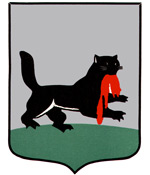
Irkutsk city map, Russia
Irkutsk city latest news and posts from our blog:.
19 April, 2023 / Steam Locomotive of the Circum-Baikal Railway .
8 June, 2021 / Irkutsk - the view from above .
4 April, 2019 / Cities of Russia at Night - the Views from Space .
16 November, 2017 / The Lost World of Tofalaria .
22 September, 2016 / The train ride along the shore of Lake Baikal .
More posts..

History of Irkutsk
Foundation of irkutsk.
The oldest traces of people who lived in the territory of Irkutsk are about 50 thousand years old. Settlements and burial grounds dating back to the Stone, Bronze, and Iron Ages were discovered on both banks of the Angara River.
Today’s Irkutsk originates from a fortified settlement laid by the Russian explorer Yakov Pokhabov in the summer of 1661. The territory on the bank of the Angara River at its confluence with the Irkut River (hence the name of the settlement) was favorable for agriculture and cattle breeding. The waterway provided communication with the Yenisei River and Lake Baikal.
In 1682, this settlement became the center of the Irkutsk Voivodeship, which included all the fortified settlements of the Baikal region. In 1686, Irkutsk was given the status of a town. After the settlement of Russian-Chinese relations by the Nerchinsk treaty (1689), trade caravans on the way to China (furs, tea, sugar, fabrics) began to pass through Irkutsk. In 1700, about 1,000 people lived in Irkutsk.
In 1719, the town became the center of the Irkutsk Province as part of the Siberian Governorate. In 1730, the merchant Lanin opened an ironworks. In 1745, the first stone residential building was built. In 1762, after the abolition of the state monopoly on the export of furs, the “golden age” of the Irkutsk merchants began. By the end of the 18th century, merchants began to play a leading role in the civil life of Irkutsk.
More historical facts…
Irkutsk - the gate of the Russian Empire to the Far East
In 1764, the Irkutsk Governorate was formed. In the 1770s, the Irkutsk fair was officially opened. In the 1780s, a public library, a theological seminary, a school, and a printing house appeared in the town. In 1790, the dilapidated walls of the fortress were demolished. Irkutsk became a kind of “window to the East” of the Russian Empire, all expeditions organized to the Far East, Mongolia, China, Alaska were formed in this town. From here the settlement of the Amur banks began.
In 1807, the first hospital was opened with private funds. In 1826, the first exiled Decembrists arrived in Irkutsk. In 1836, the first private bank was opened. In 1839, the first public library was opened. In the 1840s, Irkutsk turned into the “capital of the Lena River gold”, a place of concentration of capital of gold miners. In 1856, the population of Irkutsk was about 24,100 people.
In 1864, a telegraph line connected Irkutsk with St. Petersburg. In June 1879, a big fire almost completely destroyed the historic center of the town. The decline of the gold industry began in the late 1880s. In 1897, about 51,000 people lived in the city.
According to the initial project, the Trans-Siberian Railway was supposed to go along a shorter route north of Lake Baikal, away from Irkutsk. However, the project was changed and the first train arrived in Irkutsk in 1898. The railway caused the opening of new transport enterprises, revitalized coal mining and the forest industry, and contributed to the influx of population.
Irkutsk in the 20th century and beyond
During the First World War, more than 10 thousand residents of Irkutsk were mobilized. The industrial enterprises of the pre-revolutionary city were small and mostly artisanal. Most people were employed in trade, services, gardening, and handicraft production. During the years of the Civil War, power in Irkutsk changed several times.
In 1922-1923, Irkutsk was the center of Mongol-Buryat Autonomous Oblast, since 1930 - the center of the East Siberian Krai, since 1937 - Irkutsk Oblast. In 1923, the first stadium was built. The population of Irkutsk was 88,264 people. In 1936, the first reinforced concrete bridge named after Lenin was opened across the Angara River. In the 1930s, an aircraft factory, a metallurgical plant, a sewing factory, a soap factory, and other enterprises were built in Irkutsk.
In 1939, the population of the city was about 250,000 people. During the Second World War, about 20 thousand Irkutsk residents were drafted into the Red Army, about half of them were killed in battles. During the war, some enterprises from the western regions of the USSR were evacuated to Irkutsk. They remained in the city after the war.
In 1958, the Irkutsk Hydroelectric Power Station was commissioned. At this time, the city mainly consisted of wooden one-story houses. In the 1960-1970s, large-scale housing and industrial construction unfolded. In 1970, the population was about 451,000 people.
Until the early 1990s, Irkutsk remained one of the largest industrial centers of the Russian Soviet Federative Socialist Republic with high-tech mechanical engineering: aircraft manufacturing, instrument making, radio electronics; as well as the production of metallurgical and mining equipment, automotive parts, and machine tools. Other major industries were the production of building materials, furniture, printing, light, and food industries. The five largest factories of the city employed over 40 thousand people. In 1989, about 626,000 people lived in Irkutsk.
After the transition to a market economy, a lot of engineering and light industry enterprises were unable to adapt to the new economic conditions and closed. Over the next years, the population of the city began to decline. In 2008, the population of Irkutsk declined to 575,000 people. In 2009, population growth began again. In 2011, Irkutsk celebrated its 350th anniversary.
Picturesque streets of Irkutsk
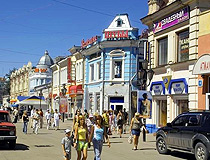
In the historic center of Irkutsk
Author: Sergey Bulanov
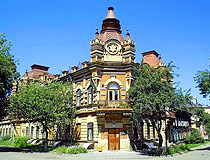
Feinberg House in Irkutsk
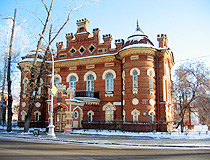
Irkutsk Museum of Local Lore
Author: Phil Johnson
Irkutsk - Features
Irkutsk is a unique, old city, the capital of Eastern Siberia.located on the banks of the Angara River in the immediate vicinity of the reservoir formed by the dam of the Irkutsk Hydroelectric Power Station, about 76 from Lake Baikal. The nearest large city is Ulan-Ude located 457 km east of Irkutsk, on the other side of Lake Baikal. The distance to Moscow is about 5,200 km.
The Angara River divides Irkutsk into the right-bank and left-bank parts. The length of the river within the city is 29 km, the width under the Old Angara Bridge in the city center is about 300 meters; there are more than 30 islands on the river.
The climate of Irkutsk is sharply continental with significant daily and annual fluctuations in air temperature. Winter is cold, long and lasts more than 5 months (from late October to early April). The coldest month of the year is January, the average temperature is minus 17.8 degrees Celsius. Summer in the first half is hot and dry, in the second half there are heavy rains. The warmest month is July, the average temperature is plus 18.3 degrees Celsius.
Irkutsk is a large industrial center of Eastern Siberia. “Irkutskenergo” is one of the largests energy companies in Russia with 3 hydroelectric power stations of the Angara River cascade with a capacity of 9 GW, thermal power plants with a capacity of 3.9 GW, as well as coal mines and regional heating systems. Irkutsk Hydroelectric Power Station produces 4.1 billion kWh per year.
The leading industrial enterprise of the city is the Irkutsk Aviation Plant, which gave the name to the current Russian aircraft manufacturing corporation “Irkut”. The plant produces military and civil aircraft and employs about 12 thousand people. Irkutsk Heavy Engineering Plant manufactures gold mining, mining and processing, and metallurgical equipment.
Irkutsk is one of the largest scientific and educational centers of Siberia. The city has a branch of the Siberian Department of the Russian Academy of Sciences with a network of scientific institutes and a number of universities, in which about 100 thousand students study.
Tourism in Irkutsk is mainly transit on the way to Lake Baikal. Foreign tourists stay in the city on average 1.5-2 days, most of them are travelers from China, Germany, and Japan. About 70% of tourists come in the summer season.
Across the left bank of the Angara, the federal highway “Baikal” Novosibirsk-Chita passes through the city. Irkutsk is the railway junction of the Trans-Siberian Railway. Irkutsk International Airport provides flights to Moscow, St. Petersburg, Vladivostok, Khabarovsk, Novosibirsk, Yakutsk. Public transport includes buses, trolleybuses, trams.
On the coat of arms of Irkutsk you can see a “babr” holding a sable in its mouth. From the 17th century, the word “babr” was used to name the Amur tiger inhabiting the Baikal region. There is an interesting story with this word.
In 1859, a large-scale reform of Russian heraldry was launched in order to correct errors accumulated over time. However, it led to new errors. The word “babr” was mostly known to local residents and the people involved in the reform decided that it was just a mistake in the Russian word “bobr” (meaning “beaver”) and approved the new description of the coat of arms of Irkutsk - a beaver holding a sable in its mouth.
However, not a single image was painted of the Irkutsk coat of arms with a beaver holding a sable in its mouth. Instead, the tiger received a large beaver tail and webbed hind legs and turned into a new, mythical animal.
Main Attractions of Irkutsk
Church in the name of the Savior of the Miraculous Image (1706-1710) - one of the first stone buildings in Irkutsk, the only building of the Irkutsk Kremlin that has survived to this day. Also, along with the Epiphany Cathedral, it is the oldest church stone building in Eastern Siberia and the Far East. Sukhe-Batora Street, 2.
Church of the Kazan Icon of the Mother of God (1885-1892) - a surprisingly picturesque Orthodox church made of bright red brick with a blue roof painted with geometric ornaments. This is one of the most beautiful buildings in Irkutsk. Barrikad Street.
Irkutsk Museum of the Decembrists (Volkonsky House) . The museum exposition is located on the territory of the estates of princes Sergey Volkonsky and Sergey Trubetskoy, exiled to Siberia after the suppression of the Decembrist uprising. These houses are monuments of urban wooden architecture typical for Siberia of the 19th century. Inside, historic interiors are recreated, giving an idea of the life of princely families. Volkonsky Lane, 10 and Dzerzhinsky Street, 64.
Victor Bronstein Gallery - a private art gallery founded in 2011. The collection has more than 1.5 thousand paintings, sculptures, and graphic drawings, which makes it the largest beyond the Urals. The exhibits of the gallery belong to various areas of contemporary art. Oktyabrskoy Revolyutsii Street, 3.
The 130th Quarter (the Irkutsk Sloboda) - a historic area located on the site of a suburban quarter of the 18th century. The decision to create the Irkutsk Sloboda was made in 2008. In this quarter, you can see restored traditional wooden houses of Irkutsk with souvenir shops, cafes, restaurants, and hotels. 3 Iyulya Street.
Sculpture “Babr” . “Babr” is the Turkic name for a jaguar or panther; the Yakuts gave this name to the Ussuri tiger. For several centuries, the image of this beast is depicted on the coat of arms of Irkutsk, it is one of the symbols of the city. In 2012, at the entrance to the 130th quarter, a bronze sculpture of a babr 3.5 meters high and 4 meters long was installed.
Lower Embankment of the Angara - a street located in the northern part of the historic center of Irkutsk, the oldest city embankment. In the 18th century, a stone cathedral of the Epiphany was erected here. Large-scale reconstruction of the embankment was carried out in 2010-2011. Today, this place is the heart of Irkutsk. Nearby you can find all the main churches and monuments, as well as enjoy beautiful views of the majestic Angara River. Nizhnyaya Naberezhnaya Street.
Irkutsk Regional Museum of Local Lore . The 19th-century mansion houses the history department, in separate buildings you can visit a natural science section and a studio where furniture and household items of the 19th and 20th centuries are presented.
On the territory of the Irkutsk Sloboda, the exhibition “Window to Asia” is open, telling about the development of Siberia and the accession of this part of the world to the Russian Empire. Tourists who decide to go to the icebreaker “Angara” will learn a lot of interesting things about shipping on Lake Baikal, and visitors who are interested in the personality of Grigory Rasputin can go to the museum named after him. Karl Marx Street, 2.
Icebreaker “Angara” . On the outskirts of Irkutsk, in the Solnechny microdistrict, you can see one of the world’s first icebreakers - the oldest surviving to this day. Produced in England, it was moved to Lake Baikal to pave the way in the ice for the ferry “Baikal” in 1900. In 1987, it was decided to restore this icebreaker and turn it into a museum ship. Here you can see unique photographs, documents, personal belongings of crew members. Marshal Zhukov Avenue, 36a
Art Museum named after Vladimir Sukachev - one of the largest museums of fine art in Siberia. Vladimir Sukachev (1849-1920) was a Russian public figure, philanthropist, collector, founder of the Irkutsk Art Gallery. The exposition presents the masterpieces of Russian, Eastern, West European, and Siberian art of the 15th-20th centuries. Lenina Street, 5.
Museum-Estate of Vladimir Sukachev . This picturesque wooden mansion twisted with carvings is a masterpiece of wooden architecture. The estate is a complex of buildings, some of which (including the main house) were restored in the 2000s. Inside, there is a memorial exhibition dedicated to the family of Vladimir Sukachev. Dekabrskikh Sobytiy Street, 112b.
Roman Catholic Church (1881). The Catholic parish was founded in Irkutsk in 1820. Most of the parishioners were Poles, who were exiled to Siberia after the Polish uprising. Therefore, the Catholic Church of the Assumption of the Virgin Mary is often called the Polish Church. In 1974-1978, the church was restored, it housed the organ hall of the Irkutsk Regional Philharmonic. Today, religious services and organ music concerts are held here. Sukhe-Batora Street, 1.
House of Merchants Shastin (House of Europe) - a manor of the late 19th - early 20th centuries also known as a “lace house” because of a beautiful carved decor reminiscent of the finest lace. The architectural style of the building is defined as Russian Baroque. The house was saved from demolition and restored from old photographs at the initiative of the French Association for the Preservation of Architectural Monuments in 1999. Fridrikha Engelsa Street, 21.
“Taltsy” - an architectural and ethnographic complex located about 40 km from Irkutsk. Here you can see a collection of monuments of the 17th-20th centuries, mostly wooden buildings from villages and towns of the region flooded during the construction of the Irkutsk Hydroelectric Station.
Irkutsk city of Russia photos
Architecture of irkutsk.
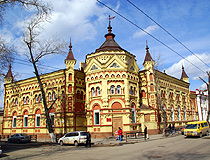
Merchant Vtorov Mansion in Irkutsk
Author: Tsvik Ilya
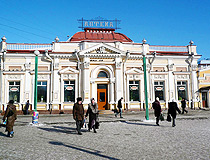
Pharmacy in Irkutsk
Author: Kusov Denis
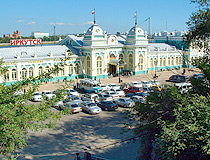
Irkutsk Railway Station
Author: Genadi Giebler
Sights of Irkutsk
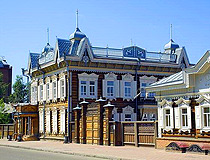
House of Europe in Irkutsk
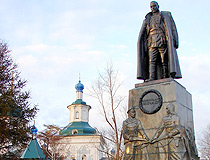
Alexander Kolchak Monument in Irkutsk
Author: V.Chokan
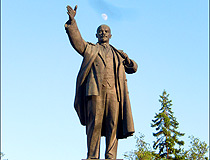
Vladimir Lenin Monument in Irkutsk
Author: Serj Kras
Pictures of Irkutsk
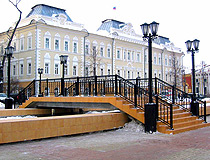
Irkutsk Oblast Court
Author: Sukhareva Elizaveta
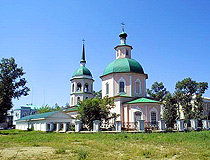
Transfiguration Church in Irkutsk
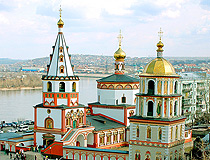
Epiphany Cathedral in Irkutsk
Author: Aleksander Reshetnik
The questions of our visitors
Irkutsk is one of the most dangerous cities in Russia in terms of criminal situation. During your visit to Irkutsk it would be better to avoid walking alone in the evening/night time, especially not in the central part of the city.
Update. This question was asked and answered in 2010. At that time, the Irkutsk region including the city of Irkutsk was on the 80th place among 83 regions of Russia by the number of crimes per 100,000 inhabitants (27.12). In 2017, the situation was better but the region remained at the bottom of the list, on the 63th place among 82 regions (19.5).
The comments of our visitors
- Currently 3.13/5
Rating: 3.1 /5 (242 votes cast)
Sponsored Links:
- Bahasa Indonesia
- Slovenščina
- Science & Tech
- Russian Kitchen
Turn Your Curiosity Into Discovery
Latest facts.
8 Facts About National Apple Pie Day May 13th
13 Facts About Love Your Thighs Day April 25th
43 facts about bratsk.
Written by Elvira Llamas
Modified & Updated: 02 Mar 2024
Reviewed by Jessica Corbett
- Industrial Center Facts
- Industrialization Facts
- Russia Facts
- Russian Architecture Facts
- Siberia Facts
- Tourism Facts
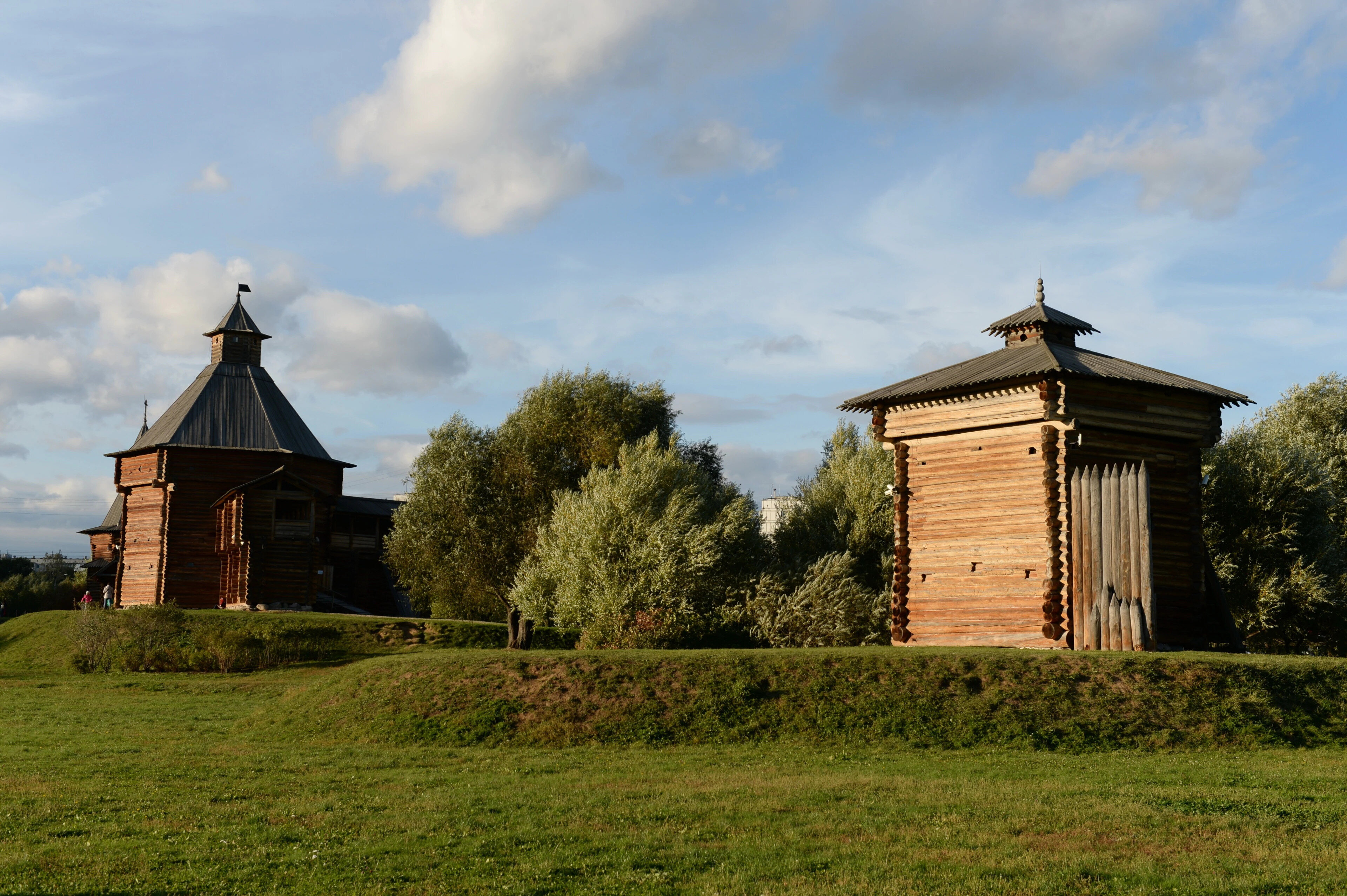
Bratsk, a city located in the Irkutsk Oblast region of Russia, is a hidden gem worth exploring. With a rich history and a vibrant culture, Bratsk offers a unique experience to its visitors. From breathtaking natural landscapes to architectural wonders, there is something for everyone in this enchanting city.
In this article, we will uncover 43 fascinating facts about Bratsk that will pique your curiosity and make you want to pack your bags and embark on an adventure. Whether you are a history buff, nature enthusiast, or someone who appreciates art and culture , Bratsk has it all. So, let’s dive into this incredible city and discover what makes it so special!
Key Takeaways:
- Bratsk, a city in Russia, boasts a rich history, stunning landscapes, and a vibrant community, offering a unique experience for residents and visitors alike.
- With its impressive hydroelectric power station, beautiful natural reserves, and diverse cultural scene, Bratsk is a city poised for promising growth and development.
Bratsk is a city in Irkutsk Oblast, Russia.
Located in Siberia, Bratsk is situated on the Angara River and is known for its breathtaking natural landscapes.
The city of Bratsk was founded on August 26, 1947.
It was established as a residential settlement for the workers of the Bratsk hydroelectric power station.
Bratsk is home to one of the largest hydroelectric power plants in the world.
The Bratsk Hydroelectric Power Station has a capacity of 4,500 MW and plays a significant role in Russia’s energy production.
The population of Bratsk is approximately 246,000 people.
It is the third-largest city in Irkutsk Oblast, after Irkutsk and Angarsk.
The name “Bratsk” is derived from the word “brothers”.
It symbolizes the unity and cooperation of the workers who contributed to the construction of the city.
Bratsk experiences a continental climate with long, cold winters and short, warm summers.
The average temperature in January is around -19°C (-2°F), while in July , it reaches an average of 18°C (64°F).
The Bratsk Reservoir, created by the damming of the Angara River, is one of the largest artificial lakes in the world.
It covers an area of 5,470 square kilometers (2,110 square miles) and provides opportunities for various water activities.
Bratsk is a major transportation hub in Siberia.
It has a well-developed railway system and is connected to other cities in the region through an extensive network of roads.
The city of Bratsk is known for its vibrant cultural scene.
It is home to several theaters, museums, and art galleries that showcase the rich history and traditions of the region.
Bratsk is surrounded by picturesque natural landscapes, including dense forests, mountains, and rivers.
The area offers opportunities for outdoor activities such as hiking, fishing , and wildlife watching.
The Bratsk Dam, which forms the Bratsk Reservoir, was completed in 1967.
It stands at a height of 124 meters (407 feet) and is an impressive engineering feat.
The construction of the Bratsk Hydroelectric Power Station required the relocation of several villages and towns.
Efforts were made to ensure the smooth transition and well-being of the affected residents.
Bratsk has a diverse economy, with industries including energy, metallurgy, forestry, and agriculture.
The city’s development is closely tied to the Bratsk Hydroelectric Power Station and the surrounding natural resources.
Bratsk is home to several educational institutions, including universities, colleges, and vocational schools.
It serves as an educational center for the region, attracting students from different parts of Siberia .
The people of Bratsk are known for their warm hospitality and welcoming nature.
Visitors to the city often praise the friendly atmosphere and genuine kindness of the locals.
Bratsk has a rich cultural heritage, with influences from various ethnic groups living in the area.
The city celebrates traditional festivals, music, and dance, reflecting the diversity of its population .
The Bratsk Fortress is an important historical landmark in the city.
It dates back to the 17th century and serves as a reminder of Bratsk’s significant role in the region’s history.
Bratsk is known for its delicious cuisine, which features traditional Siberian dishes as well as Russian favorites.
Visitors can enjoy hearty soups, smoked fish , and locally sourced berries and mushrooms.
The Bratsk Museum of Local Lore showcases the history, culture, and natural wonders of the region.
It is a must-visit for those interested in learning more about Bratsk and its surroundings.
Bratsk has a well-developed sports infrastructure and supports various athletic activities.
The city has produced many talented athletes who have competed at national and international levels.
Bratsk is surrounded by beautiful nature reserves and national parks.
These protected areas are home to a wide range of flora and fauna, offering breathtaking sights for nature enthusiasts.
The Bratskaya street, one of the main streets in the city, is lined with shops, restaurants, and cafes.
It is a popular spot for locals and tourists to stroll, shop, and enjoy a meal.
Bratsk has a well-developed healthcare system, with modern hospitals and clinics.
The city prioritizes the health and well-being of its residents by providing quality medical facilities.
The Bratsk Opera and Ballet Theater is a cultural hub in the city, hosting performances by talented artists.
It showcases ballets, operas, and other musical events, attracting audiences from near and far.
Bratsk has a vibrant music scene, with local bands and musicians performing a variety of genres.
Music lovers can enjoy live performances at venues throughout the city.
The annual Bratsk International Film Festival celebrates the art of cinema.
It attracts filmmakers, industry professionals, and film enthusiasts from around the world.
The Bratsk Circus is a popular entertainment venue, featuring thrilling acrobatic performances and animal shows.
It offers fun-filled experiences for both children and adults.
Bratsk has a strong sense of community, with various civic organizations and volunteer groups working towards the betterment of the city.
Citizens actively participate in initiatives aimed at improving the environment, education, and social welfare.
The beautiful Bratsk City Park is a favorite spot for leisurely walks, picnics, and outdoor activities.
It offers a tranquil escape from the bustling city life.
Bratsk is known for its stunning sunsets, which paint the sky with vibrant colors.
The breathtaking views make for memorable moments and great photo opportunities.
The local markets of Bratsk are vibrant hubs of trade, showcasing a variety of local produce and goods.
Visitors can explore the stalls and sample fresh fruits, vegetables, and handicrafts.
Bratsk is an important center for scientific research and innovation.
The city is home to various research institutes and laboratories that contribute to advancements in different fields.
The Bratsk State University offers a wide range of educational programs across various disciplines.
It attracts students not only from Bratsk but also from other parts of Russia and abroad.
Bratsk is a city that embraces technology and digital connectivity.
The city’s infrastructure is well-equipped to meet the demands of the digital age.
Bratsk hosts various cultural events throughout the year, including music festivals, art exhibitions, and theatrical performances.
The city’s calendar is filled with opportunities to immerse oneself in the vibrant cultural scene.
Bratsk is a city where old traditions and modernity coexist harmoniously.
While the city embraces progress, it also values and preserves its rich cultural heritage.
Bratsk is surrounded by vast forests, making it an ideal destination for nature lovers and outdoor enthusiasts.
Hiking, camping, and wildlife spotting are popular activities in the area.
The Bratsk Philharmonic Orchestra is renowned for its exceptional performances and talented musicians.
It enchants audiences with a diverse repertoire that includes classical, contemporary, and traditional pieces.
Bratsk takes pride in its strong educational system, which emphasizes the importance of knowledge and skills.
It prepares the younger generation for bright futures and successful careers.
Bratsk is a city that celebrates diversity and promotes inclusivity.
It values the contributions of people from different backgrounds and fosters a sense of unity among its residents.
The Bratsk Mosque is an important religious landmark in the city.
It serves as a place of worship for the Muslim community and represents the city’s religious tolerance.
Bratsk is a city with a strong sense of environmental consciousness.
Efforts are made to protect and preserve the natural resources and promote sustainable practices.
Bratsk is a city that holds great potential for growth and development.
With its rich resources, vibrant community, and forward-thinking outlook, it is poised for a promising future.
In conclusion, these 43 facts about Bratsk showcase the fascinating history, natural wonders, and cultural significance of this city. From being home to one of the world’s largest hydroelectric power stations to boasting stunning landscapes like Lake Baikal and the Taiga forests, Bratsk has something for everyone. Its rich history, with traces of ancient civilizations and Soviet-era industrial development, adds a unique charm to the city.Whether you’re interested in adventure tourism, exploring historical sites, or simply immersing yourself in the local culture, Bratsk offers a myriad of experiences. The city’s warm hospitality, friendly locals, and delicious local cuisine make it a memorable destination for travelers.Don’t miss the opportunity to witness the breathtaking beauty of Bratsk. Visit this city and unlock its hidden gems, unforgettable experiences, and the chance to create lifelong memories.
Q: When is the best time to visit Bratsk?
A: The best time to visit Bratsk is during the summer months of June to August when the weather is pleasant and outdoor activities are in full swing.
Q: How do I get to Bratsk?
A: Bratsk can be reached by air through the Bratsk Airport, which has regular flights from major cities in Russia. Alternatively, you can also travel by train or bus from neighboring cities.
Q: Are there any popular attractions in Bratsk?
A: Yes , Bratsk is known for its popular attractions such as the Bratsk Hydroelectric Power Station, Lake Baikal, Taiga forests, and the Bratsk Reservoir.
Q: Is Bratsk safe for tourists?
A: Yes, Bratsk is generally safe for tourists. However, it is always advisable to take necessary precautions and be aware of your surroundings, especially in crowded areas.
Q: What are some traditional dishes to try in Bratsk?
A: Some traditional dishes to try in Bratsk include Siberian pelmeni, omul fish, stroganina, and local berry desserts.
Was this page helpful?
Our commitment to delivering trustworthy and engaging content is at the heart of what we do. Each fact on our site is contributed by real users like you, bringing a wealth of diverse insights and information. To ensure the highest standards of accuracy and reliability, our dedicated editors meticulously review each submission. This process guarantees that the facts we share are not only fascinating but also credible. Trust in our commitment to quality and authenticity as you explore and learn with us.
Share this Fact:

IMAGES
COMMENTS
Economic leakage is a major problem in the tourism industry. Destinations develop and grow their tourism industries with high hopes of making a significant income from the various tourism-associated activities. However, in many destinations, this is simply not the case. I have seen economic leakage first-hand throughout almost all of my travels.
But tourism needn't be leaky or destructive. Here's are five ways to increase the good your holiday can do this summer, put money in local people 's hands, and take the pressure off ...
Leakage in the tourism industry is an economic concept. Now, if you would have told 20-year-old me, as I decided to quit my economic master's program choosing instead to pack my bags and hit the road, that I would be knee-deep in economic concepts in the tourism industry 13 years later, I would have rolled my eyes and kept driving.
Historically, economic leakage in tourism is more significant in developing countries. Sometimes it can nearly neutralize the money generated by tourism activity. In Fiji, it is estimated that 60% of the money earned through tourism ends up leaving the country. In another study, tourism leakage estimates range from 40% in India to 80% in the ...
Economic leakages in tourism are an under-researched area that requires special emphasis from the tourism academia. Leakages persist in a destination and obstruct the economic development of the region. Though mainstream literature highlighted more about the positive side of tourism development, relatively limited literature discussed about ...
Linkages help to mend local relationships with tourism, and they also come with a collective power, which can hopefully give locals a louder voice and can extend to involvement in development (to avoid displacement), to wages and so on. The overarching message is simple and familiar. It's simply 'shop local' and 'shop seasonal', as you travel.
The causes for leakages depend on the destination and its development. In small economies, the typical import-related leakage is between 40% and 50% of gross tourism earnings and between 10% and 20% in more differentiated and advanced economies (Wiranatha, Antara and Suryawardani 2017).In general, large-scale leakage has been associated with destinations dominated by major international hotel ...
Economic leakages in tourism are an under-researched area that requires special emphasis from the tourism academia. Leakages persist in a destination and obstruct the economic development of the ...
Economic leakages effectively represent the share of tourism receipts from international tourists that accrue overseas (Mitchell & Ashley, Citation 2010). Leakage is based on the funds that are spent in the destination country but not expenditure before international tourists arrive (e.g. on booking fees, flights).
Linkages between tourism and other industries is an under-researched topic. More specifically, research topics such as legal and institutional factors constraining the linkages between tourism and other local industries could fill a major gap and add to current discussion on leakages and repair strategies.
Tourism leakage causes inequality. First of all, tourism leakage is unethical because it causes inequality. According to the UN's Ocean Atlas, of each $100 spent by a tourist from a developed nation, only around $5 actually stays in the local economy of a developing country destination. There are two main sources of tourism leakage which are ...
tourism sector by e mpowering other sectors related to tourism on a local economic scale. Many fa ctors cause h igh leakages, which can be explained as follows: (1)
Reasons for Economic Leakage. Economic leakages are often cited as a primary reason that tourism does not produce the desired level of economic development in peripheral regions (Citation Britton 1982, Citation 1996; Citation Dearden 1991; Citation Dedina and Young 1995; Panos 1997).Tourist destinations that do not promote high multipliers and levels of linkages will not produce substantial ...
Leakage, economic. Leakage occurs in many industries. In the case of tourism, the causes for economic leakage depend on the destination and its development. In general, tourism leakage takes place when revenues from its economic activities are not available for reinvestment or consumption of goods and services within the same destination.
From here, Section IV, "Tourism Leakage Patterns", then explores the nature of tourism cluster leakages and the forms they may take. Then Section V, "New Directions", provides a case study of applying the cluster logic in Brazil's northeastern states, a troubled economic region attempting to implement competitiveness strategy.
leakages from tourism; (2) evaluate the strategies' effectiveness; and (3) discuss their potential to be replicated in other locations. Reasons for Economic Leakage Economic leakages are often cited as a primary reason that tourism does not produce the desired level of economic development in peripheral regions (Britton 1982, 1996;
According to the U.N.'s Ocean Atlas, as little as 5$ of every 100$ spent by a tourist in a low or middle income country stays in the local economy. This phenomenon of tourism dollars leaving the country they were spent in is called "economic leakage," or "tourism leakage.". Table of Contents.
Tourism falls within the scope of WTO - OMC activities - but because it isn't one of the hot political issues its work to date has been more routine and less high profile. It comes into play through the GATS (General Agreement on Trade in Services) - which was the end product of the Uruguay Trade Round in 1995.
Lejarraga I., Walkenhorst P. (2010), 'On linkages and leakages: Measuring the secondary effects of tourism', Applied Economics Letters, Vol 17, pp 417-421. Crossref Google Scholar
Tourism economic contribution Positive contribution when: I+X+G>S+M+T Injections I= investment X= exports G= Gov't spending Investments - building the tourism superstructure, typically by the private sector. Exports- inbounds tourism Gov Spending- investment in tourism infrastructure, etc. Leakages S=savings M=imports T=taxation savings - takes money out of the system Imports- outbound tourism ...
Founded in 1661, Irkutsk is included in the list of historical settlements of Russia. The population of Irkutsk is about 617,200 (2022), the area - 277 sq. km. The phone code - +7 3952, the postal codes - 664000-664082. Local time in Irkutsk city is April 27, 7:25 pm (+8 UTC). Irkutsk city flag. Irkutsk city coat of arms.
Irkutsk (/ ɪər ˈ k u t s k / eer-KOOTSK; Russian: Иркутск, IPA:; Buryat and Mongolian: Эрхүү, Erhüü, ) is the largest city and administrative center of Irkutsk Oblast, Russia.With a population of 617,473 as of the 2010 Census, Irkutsk is the 25th-largest city in Russia by population, the fifth-largest in the Siberian Federal District, and one of the largest cities in Siberia.
Bratsk is a city in the Irkutsk region which is on the Angara River near the vast Bratsk Reservoir. The population is not so big in comparison to other Russian towns at the 260,000 mark. The ...
43 Facts About Bratsk. Bratsk, a city located in the Irkutsk Oblast region of Russia, is a hidden gem worth exploring. With a rich history and a vibrant culture, Bratsk offers a unique experience to its visitors. From breathtaking natural landscapes to architectural wonders, there is something for everyone in this enchanting city.